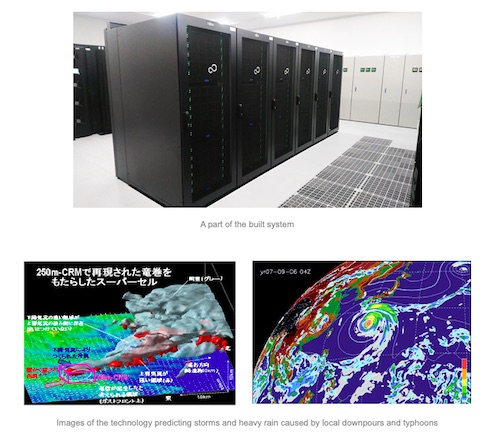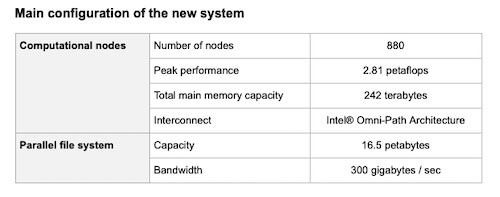Fujitsu's New Supercomputer System for Japan's Meteorological Research Institute Commences Operations
- Written by ACN Newswire - Press Releases

|
|
|
|
The new system consists of approximately 900 nodes including the latest x86 servers Fujitsu Server PRIMERGY CX2550 M5. Also, by constructing a cluster by connecting servers with a high-speed interconnect Intel Omni-Path Architecture, the system achieves the theoretical computational performance of 2.81 petaflops.(1)
Expectations for more accurate weather forecasts are increasing, as natural disasters are expanding and intensifying with abnormal weather, large-scale earthquakes and tsunamis.
Since its establishment in 1946, the Meteorological Research Institute has been conducting a wide range of research related to weather and climate forecasting. It is working to develop technologies for predicting torrential downpours and storms associated with typhoons, while addressing issues such as adaptation to global warming. Research and development are also being carried out on models for simulating conditions ranging from local weather to global climate forecasts. Moreover, efforts are being made to upgrade meteorological services, so as to achieve the world's highest level of weather forecast accuracy by around 2030.
The Institute contributes to socio-economic activities by providing accurate weather information and data, as it supports the safety and security of the population through warnings and information issued by the Japan Meteorological Agency. The system connects 880 nodes of the latest x86 servers Fujitsu Server PRIMERGY CX2550 M5, equipped with Intel's newest CPUs 2nd Generation Intel Xeon Scalable Processors, in parallel, using a high-speed interconnect Intel Omni-Path Architecture. Accordingly, it achieves high scalability for simulation applications such as weather forecasting, earthquake and tsunami analysis conducted by the Meteorological Research Institute, and can perform calculations on a wide range of applications, from small to large scales.
The system is CPU-based and does not use accelerators such as GPUs, enabling a wide range of applications to run with high performance and low power consumption. The CPU uses a water-cooling method with high cooling efficiency, which can reduce heat generation from the server with less power consumption than air-cooled systems that use cooling fans.
With the new supercomputer system, the Meteorological Research Institute plans to further advance research and development in areas such as the prediction and analysis of earthquakes, tsunamis, and volcanoes. Moreover, the system will be used for the development of high-resolution, detailed numerical prediction models as well as for research on predicting global warming.
At the same time, with its technology and experience accumulated through the development and offering of world-class supercomputers, Fujitsu will strongly support the Meteorological Research Institute in their research to achieve the world's highest level of weather forecast accuracy, thereby contributing to realize a safe and secure society.
Comment by Kazutoshi Onogi, Senior Director for Research Coordination, Meteorological Research Institute
As an institution of the Japan Meteorological Agency, the Meteorological Research Institute conducts research related to the observation, analysis, and prediction of various conditions ranging from the meteorological phenomena, terrestrial phenomena, and hydrological phenomena, while promoting the development of fundamental technology applicable to future tasks of the Agency. A precise numerical prediction model with high resolution is necessary to accurately predict storm and heavy rain associated with typhoons as well as local downpours including linear precipitation zones that cause major disasters, and to provide appropriate disaster prevention information. The new supercomputer system can meet our expectations, and we will use it to further promote our research and development, for example in predicting global warming in addition to advancing analysis and prediction technologies in the fields of earthquakes, tsunamis, and volcanoes.
(1) Petaflops Short for peta floating-point operations per second. Peta is an SI prefix indicating one quadrillion, or 10 to the power of 15, indicating the performance of one quadrillion floating-point operations per second.
About Fujitsu Ltd
Fujitsu is the leading Japanese information and communication technology (ICT) company, offering a full range of technology products, solutions, and services. Approximately 132,000 Fujitsu people support customers in more than 100 countries. We use our experience and the power of ICT to shape the future of society with our customers. Fujitsu Limited (Code: 6702) reported consolidated revenues of 4.0 trillion yen (US $36 billion) for the fiscal year ended March 31, 2019.
For more information, please see www.fujitsu.com.
Copyright 2020 JCN Newswire. All rights reserved. www.jcnnewswire.com
Authors: ACN Newswire - Press Releases
Read more //?#



